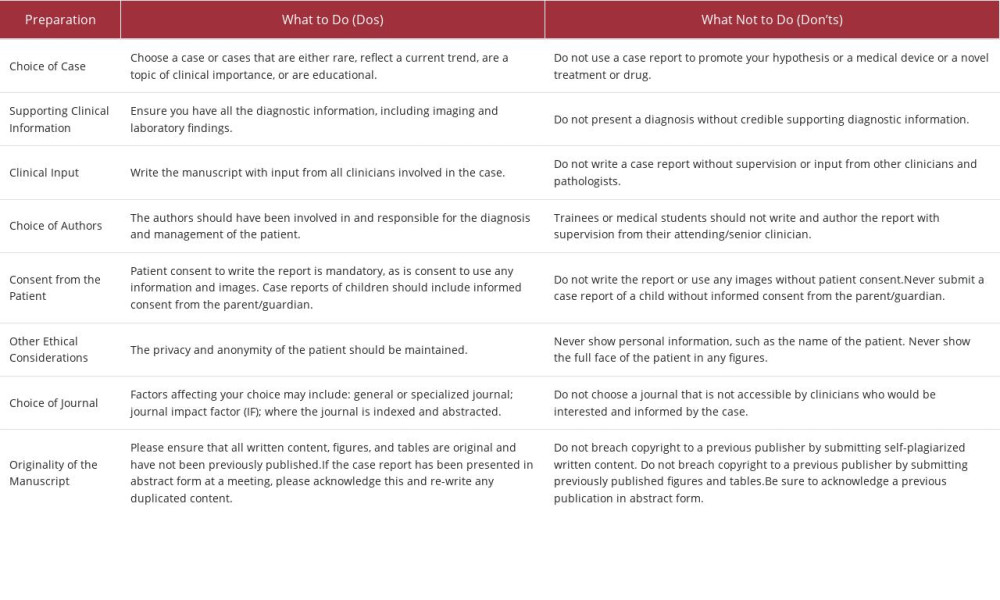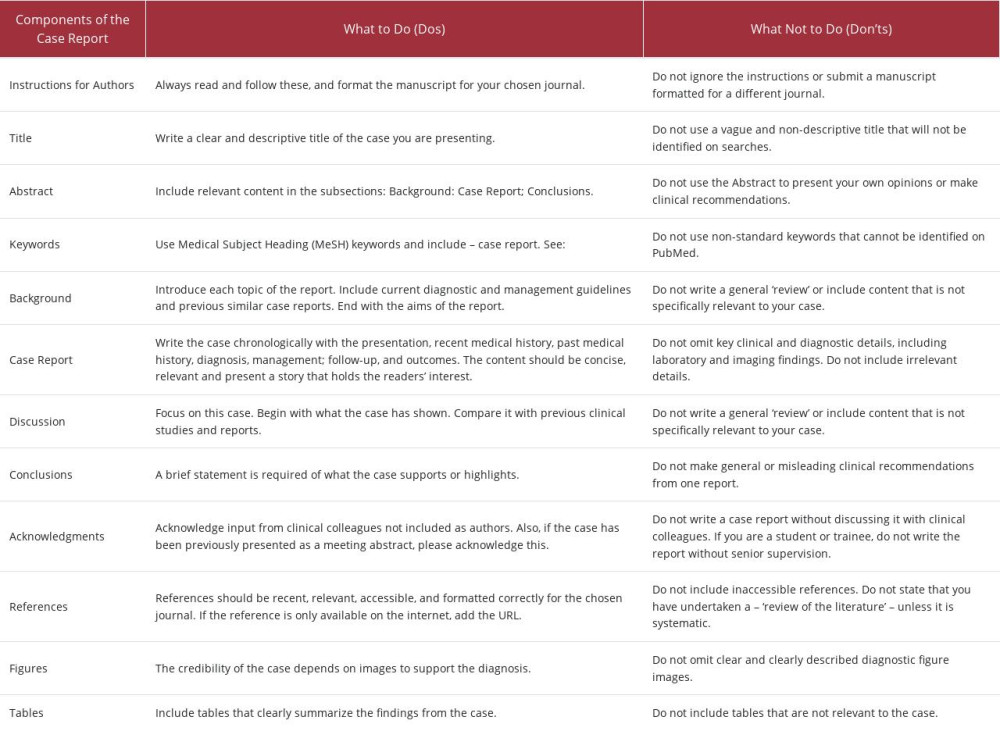01 October 2023: EDITORIAL 
Editorial: The Increasing Relevance of Case Reports in Medical Education and Clinical Practice – and How to Write Them
Dinah V. Parums1CDEF*DOI: 10.12659/AJCR.942670
Am J Case Rep 2023; 24:e942670
Abstract
ABSTRACT: Between 2012 and 2022, the American Journal of Case Reports published over 3,500 case reports and case series. In 2022-23, this journal achieved an impact factor (IF) of 1.2. The significant merits of published case reports include identifying rare diseases and syndromes, treatment complications or side effects, pharmacovigilance, and medical education. The limitations or cautions of the case report include the inability to generalize, the lack of establishment of a cause-effect relationship, and over-interpretation. Historically, new clinical conditions and syndromes have been identified. Since 2020, the COVID-19 pandemic has significantly impacted manuscript submissions and publications, as illustrated for this journal. This editorial aims to highlight the importance of case reports and series, recent publication trends and includes recommendations on what to do and what not to do when preparing and writing the manuscript for a case report.
Keywords: Editorial, case reports, medical education, Case series, Editorial, Humans, Pandemics, Writing, Education, Medical
PubMed is a publicly available search facility for more than 36 million citations in the biomedical literature, mainly from MEDLINE, the National Library of Medicine (NLM) journal citation database [1,2]. Figure 1 shows the ten-year trend in submissions to and publications in the American Journal of Case Reports between 2012 and 2022. A search of PubMed between 2012 and 2022 shows that the
The presentation of the case of a patient, including the history, diagnosis, management, and any novel aspects, is a fundamental part of medical education before and after medical qualification, which continues throughout the clinical career [4,5]. However, opinions still vary on the relevance of publishing case reports and case series to medical education and practice [4,5]. There is the view that they are of limited value at a time when medical research, drug development, and the results of clinical trials dominate the medical literature [4,5]. However, evidence also supports that they are undervalued and remain relevant [6]. In the last 15 years, the number of journals that publish case reports has increased rapidly, in line with the increase in open-access publications [5]. Currently, more than 200 journals indexed in MEDLINE and identified on PubMed publish case reports and case series [2]. At this time, the NLM Medical Subject Headings (MeSH) thesaurus search terms, ‘case report’ and ‘case series,’ identify a total of 2,417,365 case reports and 170,445 case series published in journals indexed in MEDLINE and identified on PubMed [2,7]. In 2022 alone, there were 77,800 published case reports and more than 15,000 published case series [2].
The history of medicine has shown some important landmark case reports identifying medical conditions, which may have undergone delayed recognition without these publications. Also, single case reports and case series have driven future observational and experimental clinical studies. For example, as early as 1869, Beard published the first description of ‘neurasthenia’ in the Boston Medical and Surgical Journal [8]. The condition of neurasthenia was later identified as myalgic encephalomyelitis (ME) or chronic fatigue syndrome (CFS). In February 1915, during World War I, Captain Charles Myers, a British military doctor, first identified and described the syndrome of shell shock in a publication in the
This publication was followed by case reports and case series, highlighting their role in pharmacovigilance [12]. More recently, in 2008, a case series published in the
Since 2020, the COVID-19 pandemic has significantly impacted the number of manuscript submissions and publications [15].
Initial reports were of the symptoms, presentation, and outcomes of SARS-CoV-2 infections, which then described the long-term effects of COVID-19 and responses to new treatments and vaccines [15]. Concerns have been expressed that this sudden rush to submit case reports on COVID-19 resulted in a rapid increase in manuscript submissions that was not matched by the number of publications due to reduced manuscript quality [15]. Between January 2020 and September 2023, PubMed identified approximately 20,000 published case reports and more than 5,000 case series involving COVID-19 [2]. The recent effects of the COVID-19 pandemic on manuscript submissions and publications by the
Table 1 summarizes the things to do and what not to do when preparing a manuscript as a case report, including the ethical requirements and preparation of the supporting clinical material. Table 2 summarizes the essential things to do and include and what not to do or include when writing the case report. Case reports should be reported ethically and credibly, with attention to the manuscript content, patient informed consent for publication and respect for patient confidentiality and anonymity. (Tables 1 and 2). All journals that publish case reports and case series, including the
Case reports are often the first publications for medical and surgical trainees at the start of their careers [20]. Some medical schools provide training in writing formal case reports as part of the clinical curriculum, often as part of the clinical pathology or laboratory medicine program, supported with guidance from clinical tutors [20,21]. In January 2023, Gupta and colleagues highlighted the importance of writing and publishing case reports by medical trainees and clarified the requirements for time, training, and mentorship [22]. These authors and medical educators designed and used a synchronous, virtual workshop that included trainees and academic faculty from several medical schools [22]. Trainees and clinical mentors discussed the contributions of case reports to the medical literature, identified the key content required, and the features of interesting and informative case reports [22]. Two months after the workshop, medical trainees gained confidence in identifying clinical cases with rare presentations and rare cases of interest, working with clinical mentors, and writing case reports with mentorship [22].
The major merits of published case reporting include identifying rare diseases and syndromes and complications or side effects of treatment, pharmacovigilance, and clinical education [4]. The limitations or cautions of the case report include the inability to generalize, the lack of establishment of a cause-effect relationship, the dangers of over-interpretation, and the pursuit of the rare or unusual case (the ‘first case’) rather than the informative or educational case [4]. Attempts have been made to revise the case report genre and to integrate the medical report with a narrative approach [23]. However, the narrative case report, or patient’s story, has met with limited success, possibly because of the difficulty in identifying content relevant to the clinical case, ethical concerns, and concerns with patient anonymity [23].
Conclusions
The future of the case report and case series remains assured as new diseases, syndromes, and treatments and their applications and side effects constantly evolve and require early and clear reporting in the medical literature.
References:
1.. , MEDLINE, PubMed, PMC (PubMed Central): How are they different? Dec 25, 2022 Available from: https://www.nlm.nih.gov/bsd/difference.html
2.. : National Center for Biotechnology Information (NCBI), 1996, Bethesda, MD, US, National Library of Medicine (NLM) Available from: https://www.ncbi.nlm.nih.gov/
3.. : American Journal of Case Reports, 2023, Melville, NY, USA, International Scientific Information, Inc eISSN: 1941–5923
4.. Nissen T, Wynn R, The clinical case report: A review of its merits and limitations: BMC Res Notes, 2014; 7; 264
5.. Akers KG, New journals for publishing medical case reports: J Med Libr Assoc, 2016; 104(2); 146-49
6.. Carleton HA, Webb ML, The case report in context: Yale J Biol Med, 2012; 85(1); 93-96
7.. , National Library of Medicine (NLM) Medical Subject Headings (MeSH), 2023 Available from: https://www.nlm.nih.gov/mesh/meshhome.html
8.. Beard G, Neurasthenia, or nervous exhaustion: Boston Med Surg J, 1869; 80; 217-21
9.. Myers CS, A contribution to the study of the shell shock. Being an account of three cases of loss of memory, vision, smell, and taste, admitted into the Duchess of Westminster’s War Hospital, Le Touquet: Lancet, 1915; 185; 316-20
10.. Cade JFJ, Lithium salts in the treatment of psychotic excitement: Med J Aust, 1949; 2; 349-52
11.. McBride WG, Thalidomide and congenital abnormalities: (Letter) Lancet, 1961; 278; 1358
12.. Chakra CAN, Pariente A, Pinet M, Case series in drug safety. A review to determine characteristics and quality: Drug Saf, 2010; 33; 1081-88
13.. Léauté-Labrèze C, de la Roque Dumas E, Hubiche T, Boralevi F, Propranolol for severe hemangiomas of infancy. (Letter to the Editor): N Engl J Med, 2008; 358; 2649-51
14.. Albrecht J, Meves A, Bigby M, Case reports and case series from Lancet had significant impact on medical literature: J Clin Epidemiol, 2005; 58(12); 1227-32
15.. Scaffidi MA, Gimpaya N, Li J, Completeness of reporting for COVID-19 case reports, January to April 2020: A meta-epidemiologic study: CMAJ Open, 2021; 9(1); E295-E301
16.. , American Journal of Case Reports Instructions for Authors. Available from: https://amjcaserep.com/instructions
17.. Rison RA, Kidd MR, Koch CA, The CARE (CAse REport) guidelines and the standardization of case reports: J Med Case Reports, 2013; 7; 261
18.. Riley DS, Barber MS, Kienle GS, CARE guidelines for case reports: Explanation and elaboration document: J Clin Epidemiol, 2017; 89; 218-35
19.. , Recommendations for the Conduct, Reporting, Editing, and Publication of Scholarly Work in Medical Journals Updated May 2023. Available from: https://www.icmje.org/icmje-recommendations.pdf
20.. Ortega-Loubon C, Culquichicón C, Correa R, The importance of writing and publishing case reports during medical training: Cureus, 2017; 9(12); e1964
21.. Oyibo SO, Developing a beginner’s guide to writing a clinical case report: A pilot evaluation by junior doctors: Cureus, 2019; 11(12); e6370
22.. Gupta S, Kimble A, Henry T, A case for case reports: how to write one and promote mentorship, scholarship and faculty development: Cureus, 2023; 15(1); e33299
23.. Bayoumi AM, Kopplin PA, The storied case report: CMAJ, 2004; 171; 569-70
In Press
19 Mar 2024 : Case report 
Am J Case Rep In Press; DOI: 10.12659/AJCR.943376
19 Mar 2024 : Case report 
Am J Case Rep In Press; DOI: 10.12659/AJCR.942853
19 Mar 2024 : Case report 
Am J Case Rep In Press; DOI: 10.12659/AJCR.942660
19 Mar 2024 : Case report 
Am J Case Rep In Press; DOI: 10.12659/AJCR.943174
Most Viewed Current Articles
07 Mar 2024 : Case report 
DOI :10.12659/AJCR.943133
Am J Case Rep 2024; 25:e943133
10 Jan 2022 : Case report 
DOI :10.12659/AJCR.935263
Am J Case Rep 2022; 23:e935263
19 Jul 2022 : Case report 
DOI :10.12659/AJCR.936128
Am J Case Rep 2022; 23:e936128
23 Feb 2022 : Case report 
DOI :10.12659/AJCR.935250
Am J Case Rep 2022; 23:e935250










